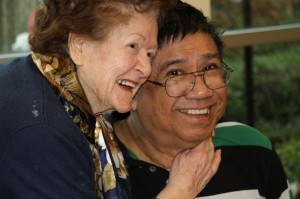Loneliness and depression, high resident to staff ratios and shrinking health care budgets—these are ongoing concerns across the spectrum of care in senior living. An emerging body of research is heralding a different approach to these critical issues. It’s our best kept secret.
And it’s not a pill.
 From a resident’s perspective, receiving help happens daily. But giving help, not so much. Residents tell us there are limited opportunities for reciprocity1 or contribution2. Giving back is simply not normally associated with who they are. Residents—particularly those living with dementia—are typically cast as passive recipients of care.3
From a resident’s perspective, receiving help happens daily. But giving help, not so much. Residents tell us there are limited opportunities for reciprocity1 or contribution2. Giving back is simply not normally associated with who they are. Residents—particularly those living with dementia—are typically cast as passive recipients of care.3
Reciprocity and Loneliness
But what is meant by reciprocity? Reciprocity is defined as support that is both given and received.4 A recent systematic literature review identified purposeful opportunities for reciprocity as a key determinant to residents’ adjustment to residential care—residents helping residents in particular5.
When it comes to the residents who are grieving losses, Kemp and colleagues (2012) stated: “To the extent that relationships with age-peers are reciprocal and satisfying, they can make up for the absence or loss of a partner and help prevent loneliness”.6
Giving residents opportunities to give back also changes their identity from passive recipients to contributing citizens. The stronger the identity, the more one perceives that one matters within the community, which in turn enhances meaning and purpose7. The more life seems meaningful and purposeful, the better one’s quality of life.8 It just makes sense.
Our Best Kept Secret
We know that giving back feels good. But how good? Giving back has a positive effect on resilience, health and well-being9, and loneliness and depression in particular.
Not only that but to give more, is to live more. Giving back is associated with living longer, increased happiness, and enhanced meaningfulness.
The tremendous benefits of giving back cannot be overestimated. Let us change how we provide psychosocial care from the focus on providing service and amenities, to one that centers on residents helping residents. Imagine a social calendar filled with abundant opportunities for residents to give back to their fellow residents. With the right supports in place, many residents can actively engage in improving the quality of life of themselves and their peers.
Let us tap into this resource that exists in all of us – the need to give. It is our best kept secret.
References
1Rash, E. M. (2007). Social support in elderly nursing home populations: Manifestations and influences. The Qualitative Report, 12(3), 375-396.
2Van Malderen, L., Mets, T., & Gorus, E. (2013). Interventions to enhance the quality of life of older people in residential long-term care: A systematic review. Ageing Research Reviews, 12(1), 141-150. doi: 10.1016/j.arr.2012.03.007
3Bartlett, R., & O’Connor, D. (2010). Broadening the dementia debate: Towards social citizenship. Portland, OR: The Policy Press.
4Keyes, S. E., Clarke, C. L., Wilkinson, H., Alexjuk, E. J., Wilcockson, J., Robinson, L., . . . Mima Cattan. (2014). “We’re all thrown in the same boat…”: A qualitative analysis of peer support in dementia care. Dementia, Advance online publication. doi: 10.1177/1471301214529575
5Brownie, S., Horstmanshof, L., & Garbutt, R. (2014). Factors that impact residents’ transition and psychological adjustment to long-term aged care: A systematic literature review. International Journal of Nursing Studies, Advance online publication. doi: 10.1016/j.ijnurstu.2014.04.011
6Kemp, C. L., Ball, M. M., Hollingsworth, C., & Perkins, M. M. (2012). Strangers and friends: Residents’ social careers in assisted living. Journals of Gerontology: Series B, Psychological Sciences and Social Sciences, 67(4). doi: 10.1093/geronb/gbs043
7Thoits, P. A. (2012). Role identity salience, purpose and meaning in life, and well-being among volunteers. Social Psychology Quarterly, 75(4), 360-384. doi: 10.1177/0190272512459662
8Haugan, G. (2014). Meaning-in-life in nursing-home patients: A correlate with physical and emotional symptoms. Journal of Clinical Nursing, 23(13-14), 1830-1844. doi: 10.1111/jocn.12402
9Jetten, J., Haslam, C., & Haslam, S. A. (2012). The social cure: Identity, health and well-being. New York, NY: Psychology Press.
10Jung, Y., Gruenewald, T. L., Seeman, T. E., & Sarkisian, C. A. (2010). Productive activities and development of frailty in older adults. The Journals of Gerontology, Series B: Psychological Sciences and Social Sciences, 65B(2), 256-261. doi: 10.1093/geronb/gbp105
11Schwartz, C. E. (2007). Altruism and subjective well-being: Conceptual model and empirical support. In S. G. Post (Ed.), Altruism and health (pp. 70-81). New York, NY: Oxford University Press.
12Cruwys, T., Haslam, S. A., Dingle, G. A., Jetten, J., Hornsey, M. J., Chong, E. M. D., & Oei, T. P. S. (2014). Feeling connected again: Interventions that increase social identification reduce depression symptoms in community and clinical settings. Journal of Affective Disorders. doi: 10.1016/j.jad.2014.02.019
13Post, S. G. (2011). It’s good to be good: 2011 fifth annual scientific report on health, happiness and helping others. Ohio: Case Western Reserve University.
